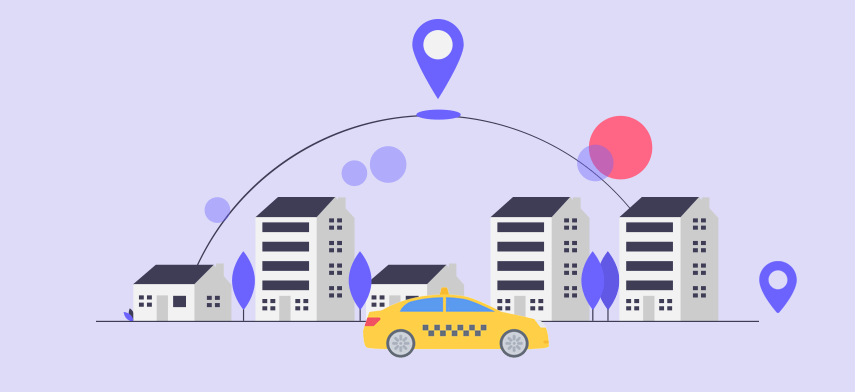The presence of technology is ubiquitous today, facilitating our lives in more ways than meets the eye. Its applications have become indispensable in our day-to-day lives and its influence is far-reaching, shaping an increasing number of our decisions and actions. Taxi-hailing apps are a part of such a technological sphere in which every personal encounter is designed to promote comfort, riding experience, and user convenience. This direction of emphasis has made things easier for both riders and the company.
Today, a company like Uber is in the driving seat in the taxi-hailing app business. CNBC rated Uber second on its list of most disruptive companies in the world in the year 2018 (after SpaceX). To detect a potential customer and convert them into a regular user, Uber provides a 50-percent discount on the first ride taken by each new rider. Uber has created a market for taxi-hailing apps and the lack of access to such a service today may be considered a compromise of personal comfort.
If you are planning to launch a burgeoning taxi-hailing app, you should study the focus and the model of operation that Uber has followed before stepping into the industry as a worthy competitor.
What is the binding factor in the taxi industry?
Without a functional GPS network, the effectiveness of taxi-hailing apps cannot be retained. GPS is beneficial for all the parties involved in the taxi-hailing ecosystem - the customer, driver, and the admin. Hence, a taxi-hailing app is crucial in connecting the driver with the customer. GPS also facilitates the ease of picking up or dropping off a customer on time and at the right location.
Technology does most of the heavy lifting in any application. For the taxi business, the integration of GPS in the application constitutes the root technology. Before any actions are planned towards achieving a goal, clarifying two questions (“What technology is most appropriate to use?” and “How to go about it?”) are vital considerations. In the taxi-hailing ecosystem, Google Maps API integration has answered both of these questions.
Why Google Maps?

Google Maps is a crucial point of entry towards using technology intelligently. Google Maps has simplified the meaning of living across borders. It has transformed the ways in which we ride to work, search for our favorite places, and explore new locations. The essence of Google Maps API is to innovate simpler, easier, and scalable driving standards worldwide. This mapping service is used by the largest number of taxi-hailing apps .
Here are a few reasons why Google Maps API integration is the desired solution for various taxi-hailing apps:
1Allows Extensive Navigation
Google Maps is the only virtual technology that has relevant mapping data from all around the Earth. This presents the most extensive navigation possibilities as a result of Google Maps API integration. Thus, even the most secluded regions on Earth can be mapped, accessed, and developed as regular cab transportation routes with the help of GPS.
2Data Availability
The current version of Google Maps is a result of years of data gathering, making it a form of technology without equal in terms of penetration and coverage. It provides information on every aspect of traveling: traffic schedule, shortest route, distance in time and kilometers, road layouts, etc. With so many data-driven insights, no wonder taxi companies prefer Google Maps API integration in their taxi-hailing apps.
Now, let us take a look at the paramount APIs that taxi-hailing apps should integrate.
Google Maps APIs that you must integrate:
Google Maps was introduced to the world almost fourteen years ago and the evolution of this location-based API has never stopped ever since. In the year 2018, Google announced the advancement of its core API: “We are simplifying our 18 individual APIs into three core products - Maps, Routes, and Places, to make it easier for you to find, explore, and add new features to your maps and sites”. Once a taxi-hailing app starts reaching its maximum capacity, the next follow-up step for any company is to retain the largest number of customers. The various types of taxi management software play a vital role in customer retention.
- Self-Reach of API
Application Programming Interface (API) enhances navigation. Have you ever seen a drop down list of locations as soon as you enter a few alphabets of your pickup or drop-off location? Well, this is the magic of an API. It automatically acts intelligently and searches for places that are similar to the letters that you have typed. The API will begin its work whenever you start typing in any location on the search bar. This enables the customer and the driver to fetch an accurate location. Generally, it takes 4-6 API calls to determine the pickup and drop-off location for a user.
- Integrating Google Maps with API
Geocoding API is what helps in locating an exact route. After selecting an accurate location, Google Maps API integration will fetch that exact place via the assistance of latitude and longitude. This API is the model for mapping locations on the map.
- Distance Matrix API
The convenience of knowing the time and distance between the pickup and drop-off location is provided by the API. In order to fetch an accurate prediction of minutes or hours and kilometers, it is vital that the two location points are mentioned on the map. This mapping technique aims to determine the shortest and the quickest route to reach the final destination. Furthermore, it prevents the application from providing any false information by tracking the driver and his/her movements.
- Direction Matrix API
As the name suggests, this API fetches the distance between two points. This helps the driver to reach the pickup location following a convenient route while facing a minimal delay. Furthermore, Google Maps API integration provides the customer and the driver with an estimated time of arrival (ETA). Furthermore, it also provides insights with regard to the fare estimation, which is calculated on the basis of the following factors:
- Demand and supply of taxis
- Traffic conditions
- Weather conditions
- The route
- Stationary Map API
Whenever a location is found on Google Maps, a static image of the location and routes is determined. With the URL parameters, Google Maps Integration creates a map of that particular place. These URL parameters require standard HTTP communication.
Is a taxi-hailing app a feasible solution without a financial foundation?
In comparison to traditional service models, a conventional taxi business involves a lot of unavoidable costs - vehicle insurance, licensing costs, office cost, etc. without any guarantee of making a profit from such expenses. However, now, the cab business scenario has completely changed. With the introduction of the taxi-hailing apps, companies can easily understand the supply and demand graph and can fulfill the requirements of a taxi-hailing app without worrying about initial investments.
Final Thoughts
Traveling does not merely involve going from one place to another - it is the comfort, convenience, and timeliness of the journey that is also a part of the experience of any journey. Google Maps API integration provides much-needed support to facilitate this venture. It gives taxi-hailing app companies a vision to explore the unknown in the day-to-day world, linking the ease of movement with advanced, cutting-edge technology.
GPS and API are two integral parts of any taxi-hailing application. As a new entrant into the sector, you should perform an analysis of which technology can fulfill your requirements best according to your investment horizon. If you are an entrepreneur and are looking for smart and feasible solutions to delve into this industry, then look no further - Taxipulse has solutions to all your technological problems.
Author's Bio


